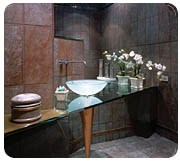
For almost as long as he can remember, Charles Rabinovitch of C.M. Rabinovitch/Architects in New York wanted to be an architect when he grew up. He was first inspired at the age of nine when he visited an exhibit on the work of renowned French architect Le Corbusier.
Rabinovitch went on to pursue a bachelor’s degree in architecture from City University of New York and a Master’s Degree from Cornell University. After working for three years at Proposition Architecture - a young firm in Manhattan where he learned a great deal about loft conversion and re-use of industrial commercial buildings - and receiving his architect’s license, Rabinovitch went on to start his own firm.
Today, the architect’s business primarily consists of high-end residential work in the New York Metropolitan area. His designs are innovative and almost always are a beautiful showcase of stone and tile. Rabinovitch diligently attends classes and seminars to maintain his accreditation as well as to keep abreast of the latest product developments in the field.
Recently, Contemporary Stone & Tile Design had the opportunity to tour one of Rabinovitch’s recent projects at Trump Tower in Manhattan, which has been featured on HGTV, and speak with him about his use of stone and tile in design.
CSTD: When did you first develop an interest in architecture?
Rabinovitch:Actually, my first interest that I can remember was when I was a kid. I was probably nine or 10 and I went to an exhibit of modern art. It was on Le Corbusier’s work. I think he had just died at that point, or sometime just before that. So, that was really my first concrete connection of architecture as something real and as something that I was interested in doing, and I have actually pretty much kept that through since then.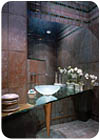
Charles
Rabinovitch of Charles M. Rabinovitch Architects in New York specializes in the
design of high-end homes in the New York Metropolitan area. The glass bowl sink
and vanity combined with warm hues of the porcelain wall and floor tile creates
a contemporary yet cozy feel in the powder room of this Manhattan Penthouse.
CSTD: Did you go to school specifically for architecture?
Rabinovitch:Yes, by the time I went to college I knew that I wanted to study architecture. I had always had an ongoing interest in it, but I never had really brought it to any concrete level of building or anything like that. So, that was my first dose of reality. And then of course, after working and being licensed and going through all that, I had been re-educated in terms of really learning and unlearning what I learned in school. I learned the reality of practicing architecture as opposed to being taught largely by people who had already left the practice of architecture because they didn’t want to do that.CSTD: Where did you go to school?
Rabinovitch:I have a bachelor’s degree in architecture from City University of New York, and then I worked for a period of time and went back to get a Master’s Degree from Cornell University.CSTD: Once you graduated, what was one of your first jobs as an architect?
Rabinovitch:I worked for a young new firm in New York, which was called Proposition Architecture. That was kind of indicative of their whole approach, which was that it wasn’t about the people’s names but about a whole attitude about architecture. This was at a period in the early ‘80s when there was a lot of loft conversion work just happening in Manhattan at that time - re-use of industrial commercial buildings, particularly in lower Manhattan, which was where the firm was located.I got excellent exposure and practical experience at that time. And it was also an excellent opportunity because I was really the second employee of the firm. It grew very rapidly at that point, so I was very quickly in a position of responsibility - especially in terms of design work. The proprietor of the firm was very happy to relinquish that part of it. He could then really focus on the business aspects. Although, because of the nature of the firm, we were all very involved in all the happenings - both the real workings of the project as well as the design aspects.
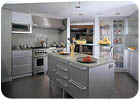
For
a recent renovation of a private residence in Easton, CT, a unique sea foam
green-colored natural quartzite was installed as countertops and tabletops in
the kitchen. Stone Supplier: Stone Source, New York, NY; Tile Supplier: Studium
CSTD: How long did you stay there?
Rabinovitch:I stayed just long enough so that I was able to be licensed. It was about three years, which at that time in New York, was the requirement to be licensed. I was seeing the real workings of the office very first-hand; not only learning about it, but being in a position to make connections with many of the clients who were looking to do other things. It was a good combination in that way. Some of them were people who were contacts and connections that I made through those jobs.CSTD: Do you think your philosophy and design style has changed much since you first started?
Rabinovitch:It certainly has been more refined. Although, the basic thrust - in terms of pretty much a contemporary approach to space and materials -has been pretty consistent. Mainly it has become more focused and refined.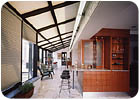
The
marble also served as a complementary element to the darker wood cabinetry.
CSTD: Have you always used stone and tile in your designs?
Rabinovitch:Yes. I find now, for example, we particularly do a lot with blending the two materials. First of all, it is often a way to get particular effects. There might be one surface that needs a more practical material, but you want the impact of a natural stone. Just by the nature of the fact that we do a lot of residential high-end work, it is pretty much across the board.I think the whole perception of the use of stone and tile has changed radically in the last number of years. It went from stone being a fairly esoteric material that people saw at Lincoln Center or something, and wouldn’t think of putting limestone in their kitchen, to being much more accepted in residential use and considered something that is almost standard in that level.
CSTD: Do you find that your clients are more educated about materials than in the past?
Rabinovitch:It is interesting. They definitely are more educated. And some of them are a little overly educated, but not in a positive way - meaning they are aware of things, and see stone and tile on [design] shows on HGTV, but it doesn’t necessarily give them an understanding. Of course, this is what we are hopefully there for - not only technically, but in terms of the design and what is appropriate. So, very often, it is a matter of having to talk clients out of preconceived ideas, like, “I saw this somewhere in a hotel, and I want to use it here” - that kind of thing.And, you know, it can be very tricky. Even now, we are currently involved with projects where the use of natural stone is very touchy, with a client who doesn’t understand the reality of using natural stone in a residential setting.

The
use of stone in this Manhattan residence continues into the bathroom, where 1-
x 1-inch mosaic pieces of Jerusalem Stone form the floor. Additionally, a colorful mosaic border
punctuates the warm limestone tile walls. Stone Supplier: Studium, New York, NY (wall tile and mosaic)
CSTD: So what are some ways that you go about educating clients?
Rabinovitch:Well, at the beginning stage of a project, you try to educate them in terms of going through material choices and putting together a palette of materials. And of course, very quickly, the point will come up where it will be used and whether it is an appropriate type of material for that particular kitchen or bathroom use. But, often people aren’t necessarily interested in being educated, and they have preconceived ideas. So, it can be a matter of persuasion, and sometimes more than that to try and make sure the right material is used.Sometimes we don’t realize enough about the client to know what we should have told them - until afterwards. For example, we are in a situation with a project that is just being completed now in Westchester, NY. The client had seen this completed residence of ours [in Trump Tower] and loved this particular stone. We wanted to get a similar stone to use in the kitchen and dining areas. We found a comparable stone, and I did all the usual things of explaining that you have to understand that this is not a pristine material that will stay that way naturally. To make a long story short, the stone was installed, and the client was actually living in the project while it was being renovated. They started using the kitchen a little bit as they were living there. I don’t know what they were preparing there, but it started to show some immediate signs of wear and staining. The client kind of flipped out and asked how we could allow them to use this material and that whole scenario. We are now just trying to resolve it by having an outside stone consultant come in and reseal it.
This particular installer didn’t know about these various sealers that have been developed for different kinds of stone finishes. This was limestone with a honed finish, and he just used some generic sealer on it. We now have to have the stone refinished after a month of use. To some extent, it makes you a little bit leery of using stone in certain situations. You know it is the right thing aesthetically, but you almost hesitate to do it, because it can come back to haunt you. I don’t know what the solution to that is. It’s interesting when you talk about the client being educated, because I find that many people working in the industry aren’t up on a lot of things.
CSTD: I think you are right. A lot of them used to be tilesetters, so they understand that aspect of it, but they don't necessarily know stone. You hear a lot of fallacies like, “Once you have granite, that's maintenance-free,†and that's not really true.
Rabinovitch:Or the converse: “You can’t use limestone in the kitchen. It will never work.” And the case in point here is actually a fellow that I have worked with for a number of years. He is from Europe, and he does beautiful stone installations and started his own business. And I forget to realize that even though he might know stone on that level, he is just not up on a lot of things in the market. We have started doing installations in some more recent projects using a lot of the Schlüter [Systems] products. And [installers] wouldn’t know what you are talking about.Doing renovations in Manhattan, there is always this issue when you are changing floor plans. Co-op managements don’t want you to put wet spaces like kitchens over areas that are not, which is kind of a silly thing. But the way it is usually addressed is putting in these waterproof membranes that Schlüter and other companies make. And it has been a whole process of trying to educate the installers, because you specify some of these products, and they’ll just either totally ignore it or look at it, have no idea what it is and instead of finding out, say, “Oh, it’s nothing.”
This just happened. We specified a 2,000-square-foot floor using this Schlüter-Ditra membrane - which I had really just learned about using on my own house, and found it to be great. So, we specified it, and the guy came in with a bid and afterwards started the work, but I saw that he wasn’t using it. So I asked him what was going on. He never really understood what it was. He thought it was just something that he just was not going to do; not to mention that it is not an inexpensive material, and it is extra installation, and it ended up creating a whole issue. And the designer or architect becomes almost the villain in that case because the owner is saying, “Maybe we shouldn’t do it then. Why don’t you leave it out?” And you know that it is the right thing to do there. And now of course the guy wants twice as much money to do the job. So, that whole education thing goes in both directions.

In
the kitchen of the Trump Tower residence, French limestone countertops feature
a sandblasted Pompignon Patina finish, which complement the Yellow Bulgarian
limestone floor and serve as a counterbalance to the sleek aluminum cabinetry.
Stone Supplier: Haifa Inc. (French
limestone)
CSTD: I have heard that in architecture school there is very little education on materials themselves - certainly not on stone. Have you found that?
Rabinovitch:I’ve been out of school a little while, so I don’t know how much that has changed, but certainly my own experience was that it was considered a necessary evil. You had to know about this stuff, but it wasn’t something that they were going to waste their time teaching you about. To that extent, if you look at the “Bauhaus” where they were very focused on skills and craft and building and understanding materials, that was something that was sorely lacking [in school] - especially with stone. Again, particularly when I was in school, it wasn’t even that common as it was in Europe, with the whole history of using stone. It was just something that some Italian guys knew about, but you didn’t have to know very much, and that was about it.CSTD: How do you go about learning about new products?
Rabinovitch:New York State now has a continuing education requirement. And I must admit, I have learned a fair amount going through classes. Even Schlüter runs a seminar. Last year, I think, there was a whole series run by the Tile Council of America. I find that is an excellent way to keep up on things like the Schlüter products, which are certainly pretty new technology. That, and being in touch with good tradespeople who are also doing these things and who are willing to share information. For example, the general contractor [for the project with the Schluter-Ditra membrane] is now using Ditra on all of his jobs.People are very intimidated when they first hear about it, and see this strange-looking orange mat. And right now, they just don’t even think about it. It is a very short learning curve, but it is something, and I think a lot of learning goes on that way.
CSTD: Do you spend a lot of time on the jobsite supervising?
Rabinovitch:That’s the very nature of many of the projects we do. It’s heavily involved in on-site supervision. Though, when it comes to the actual stone and tile work, the difference when monitoring the job progress versus not being there can be almost catastrophic.I had this experience just now working on my own home. In the kitchen, we did the floor in a kind of gray/gold Jerusalem Stone large-format tile. [The installer] is someone that I have worked with before, but I had to stop them from working for a while. It’s a very sensitive layout of material in terms of the flow of the pattern and texture. Even there, I had to be right on top of it just to make sure that it was installed in an aesthetically pleasing way.
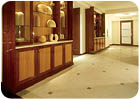
This
private residence in Trump Tower in Manhattan features a stone centerpiece
custom made from two varieties of Bulgarian limestone. Stone Supplier: Paris
Ceramics
CSTD: Now that we have talked about some of your more challenging experiences with stone, do you have some positive experiences that you would like to share?
Rabinovitch:This is a negative story that turns out positive. We are working on a new residence in Brooklyn, which is a waterfront property on Jamaica Bay. The client - unlike most of the homes in the area - was interested in a very contemporary, clean, almost minimalist-style house. The main level of the home is about 2,000 square feet. It’s an open plan space - living, kitchen, eating areas - and the intention was to have a very light-colored space. Even though there is natural light, it doesn’t penetrate into the space so much.We had selected a very light limestone. This was going on concurrently with the other [limestone kitchen] project I had mentioned to you, and having been a little bit chastened from that experience, I was very reluctant to let the client use this stone. I kept trying to talk them out of it. In fact, I took them here [to the Trump Tower residence] to see the Bulgarian stone, which I knew was not exactly what they were looking for but I thought was more manageable. But, they were thoroughly insistent that they understand and they wanted that stone.
We ordered 2,000 square feet of limestone. We actually bought it well in advance because we wanted to make sure that we had [enough material to complete the project]. It was brought to the stone contractor’s yard to store, and then about four or five months later we were ready to start installing it. So, they brought all the materials to the site and opened it up. At least half of it was thoroughly stained with what almost looked like a rust stain. And some of it was also broken inside the crates. This turned out to be a real nightmare. We went back to the supplier right away and said that this is not acceptable. We got conflicting stories, but some of their people said that they never even saw the material. It came from somewhere in Europe, and they just unpacked it and reshipped it, so they said they couldn’t have done anything to damage the stone. Of course they blamed us in the storage stage. This was going back and forth for a long time.
Meanwhile, the project had come to a standstill because we were using a radiant floor heating system and that was the next thing that had to happen. The client was flipping out because he had spent about $20,000 on this stone. So, something had to happen, and we were not getting any resolution. I must say; I was really shocked - not even on the not accepting responsibility of the supplier, because that I can almost understand - but on their attitude, which was like “drop dead.” They were totally inaccessible. They made themselves totally scarce. We were dealing with one of the owners of the company, and he just basically avoided dealing with it, and that was really shocking. I have dealt with that particular supplier before, and it was not a small order; it’s that kind of thing that doesn’t give the stone industry a great name.
There was a person in their New York showroom that was nice and helpful, but had absolutely no power to do anything. So, we were getting nowhere fast. I convinced the client for right then he had to bite the bullet and get some new material - and I said, “It is not going to be natural stone there, because this isn’t going to work for you.”
[So we turned to a] supplier/showroom, Studium, which does a lot of custom stone assembly and mosaic work, and I have worked with them for many years. They had just gotten a new porcelain material from the manufacturer Cotto d’Este. [At first], the client did not want to use this, because all the porcelain “stone” we had seen in the past had that look that was trying too hard to look like stone. But this particular one was a new product, and because of the circumstances, I convinced him to use it. We had to buy another 2,000 square feet of material that was installed right away. I would say that I was favorably impressed with the material. And going back to all the things that we discussed before, it really solves so many of those issues. It is not natural stone, but it gives a very beautiful close appearance with a fraction of the headaches.
CSTD: They have come a long way with those types of stone-look tiles.
Rabinovitch:Oh, completely. And this was a large format. It was a 24- x 24-inch that we used there. So it had even a bigger stone look than the real stone in that sense. It’s a very wide sweeping space. And also, that is where we used the Schlüter-Ditra with this contractor for the first time. So, it was a combination. It was a wood-frame structure, and I thought it was an excellent application to use it on. What was a very negative experience became a good positive learning experience. And in the long run, the truth is, he would have been very unhappy with that [stone] material. It is a family living situation, with lots of traffic. This porcelain is ideal. It looks as fresh everyday as when it was put in. And the funny part is that he has this [stone] material sitting there, which he is using in the basement of all things, just because he has it. So this beautiful limestone with a honed finish is going underneath the ping-pong table. That was kind of full circle.We are actually nearing completion, and there is a lot of exterior landscaping work. There’s a pool, patio and deck. The client, even after his experience with the stone still wanted to use natural stone outside, but we were getting all kinds of outrageous quotes for what was basically travertine pavers. We somehow made a connection with a Turkish importer who’s based in Newark that directly imported the material. They had an unbelievable price. The material was taken directly from the container and brought here, and turned out to be beautiful - even nicer than the sample we had selected from. They are installing about 2,000 square feet of this paver now for the exterior.
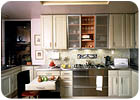
In
the renovation of an apartment in a pre-war Manhattan building, Rabinovitch
selected to integrate accent bands of Oceanside Glasstile mosaics with
large-format Italian porcelain tile for the floor pattern. Tile Supplier: Oceanside Glasstile, Carlsbad, CA (glass
mosaics)
CSTD: So, when you do start a design, how do you go about choosing a material palette?
Rabinovitch:Usually, a lot of it will come out of the inherent qualities of the project. For example, here [in the Trump Tower residence] we had a particular image of the type of space that we were trying to create. So, by definition, with the exception of the powder room, it implied very neutral colors, very even materials and very little stone with heavy movement. The stone in the kitchen has a lot of natural variation, but is still in a very limited color palette.If there is a particular fabricator that we know will be doing the project, we will often start with the materials that they happen to have. They will often be reluctant to find more unusual things, because it is in their interest to use materials that they have at the time. Very often, we will then have to go to other suppliers, which was the case here [with the Trump Tower residence], for example, to get particular stones. I’m sure these are very common things that you hear, because there is a lack of standardization of names and materials in the industry. It often becomes very hard to be insistent on particular materials. We’ll show somebody a sample, and then two months later when it’s time to fabricate the job, they come and it is not really the same material. It really just gets down to the same issue. You really have to be very vigilant with the use of stone and have the right type of project where you can ensure that you will end up with what you started looking for.
On the type of projects we do, the use of stone is the biggest wild card in the whole process. Almost invariably, that’s where you can expect that there are going to be problems on a typical job. Between supply, installation and after-installation, there are just so many variables that can go wrong or just be different. Even wood cabinetry is so much more predictable and more controllable.
CSTD: What are some trends you are seeing now with stone and tile as compared to five or 10 years ago?
Rabinovitch:In tile, especially, there seems to be so much more product and variable types of material - even just the range of glass materials. When we used the glass tile here in the kitchen [of the Trump Tower residence] for the backsplash, it was not brand new, but even then, which was pretty recently, it was something relatively just developing. This was considered a very unusual material. In the last couple of years, the range of material, finishes, formats - everything - has exploded. That’s just one trend. And obviously, even though I guess they aren’t “making” more stone, the stone that is available [is different]. I guess it is coming from wider areas, and in terms of finishes.It is typical of the whole design industry in general - appliances as well. It becomes harder and harder to keep abreast of what is available. Very often clients will now say they saw something, and you might not even know what it is. You have to constantly keep on your toes with that. But the other side of the coin is that you still have the basic ideas of what you try to do and the ways to use them. You still have to have those design tools, which hold true 10 years ago or 20 years from now. There are certain consistent aspects of how you bring them into a project.
CSTD: Is most of your work in the New York Metropolitan area?
Rabinovitch:Yes, pretty much. We do work outside of the area, but right now we are mostly in the Tri-State area [of New York, New Jersey and Connecticut].
Rabinovitch
was responsible for a prototype boutique for American Jeans in New York City.
"I would say people tend to be a little more inventive or risk taking in
retail spaces," said the architect. "There were a lot of things that
we could experiment with on those types of projects that people might not have
been willing to use in their home."
CSTD: Are you doing mostly residential work?
Rabinovitch:Right now we are basically doing all residential, but in prior years it was pretty much split between high-end residential and commercial projects.CSTD: When you were doing commercial work, did you find that your clients were different than your residential ones?
Rabinovitch:Yes. Most of the commercial work we were doing tended to be retail and office spaces. First of all, there was a very different approach to it. It was a business venture. And particularly in the retail space, money was spent with the intention of how it would come back to be helpful. So the whole approach in budgeting and initial design was different.For one store, we had a stone floor, which in a very short time became scuffed. And this was not a large retailer with a whole maintenance staff to deal with these things. So, it was a learning experience for them to understand that they had to polish the floor once a month, etc. I would say people tend to be a little more inventive or risk taking in retail spaces. There were a lot of things that we could experiment with on those types of projects that people might not have been willing to use in their home.